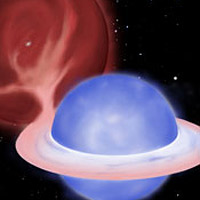Solar Micro Car Kit DIY STEM Kit
$9.99$5.95
Posted on: Oct 21, 2011

An artist’s conception showing a blue straggler being created by mass transfer in a binary star system. The giant star, seen in red, has lost hold of its outer envelope. This material is pulled towards its partner, forming an accretion disk, and is eventually consumed by the 'proto-blue straggler.'
(Illustration by Aaron Geller)
Mysterious “blue stragglers” are old stars that appear younger than they should be: they burn hot and blue. Several theories have attempted to explain why they don’t show their age, but, until now, scientists have lacked the crucial observations with which to test each hypothesis.
Armed with such observational data, two astronomers from Northwestern University and the University of Wisconsin-Madison report that a mechanism known as mass transfer explains the origins of the blue stragglers. Essentially, a blue straggler eats up the mass, or outer envelope, of its giant-star companion. This extra fuel allows the straggler to continue to burn and live longer while the companion star is stripped bare, leaving only its white dwarf core.
The scientists report their evidence in a study to be published Oct. 20 by the journal Nature.
The majority of blue stragglers in their study are in binaries: they have a companion star. “It’s really the companion star that helped us determine where the blue straggler comes from,” said Northwestern astronomer Aaron M. Geller, first author of the study. “The companion stars orbit at periods of about 1,000 days, and we have evidence that the companions are white dwarfs. Both point directly to an origin from mass transfer.”
Geller is the Lindheimer Postdoctoral Fellow in the Center for Interdisciplinary Exploration and Research in Astrophysics (CIERA) and the department of physics and astronomy in Northwestern’s Weinberg College of Arts and Sciences. Robert Mathieu, professor of astronomy and chair of the astronomy department at UW-Madison, is co-author of the study.
The astronomers studied the NGC 188 open cluster, which is in the constellation Cepheus, situated in the sky near Polaris, the North Star. This cluster is one of the most ancient open star clusters, but it features these mysterious young blue stragglers.
The cluster has around 3,000 stars, all about the same age, and has 21 blue stragglers. Geller and Mathieu are the first to use detailed observational data from the WIYN Observatory in Tucson, Ariz., of the blue stragglers in NGC 188.
They used the information to analyze and compare the three main theories of blue straggler formation: collisions between stars, mergers of stars and mass transfer from one star to another. The only one left standing was the theory of mass transfer.
The light from the blue stragglers’ companion stars is not actually visible in Geller and Mathieu’s observations. While the companions haven’t been seen directly, their effect on the blue stragglers is evident: each companion pulls gravitationally on its blue straggler and creates a “wobble” as it orbits, and this allows astronomers to measure the mass of the companion stars. The WIYN data show that each companion star is about half the mass of the sun, which is consistent with a white dwarf.
The other two origin theories -- collisions and mergers -- require the companion stars to be more massive than what is observed. In fact, in both scenarios, some of the companion stars could be bright enough to be visible in the WIYN data, which is not the case.
“We think we have a good understanding of stellar evolution, but it doesn’t predict blue stragglers,” Geller said. “People have been trying to explain the origin of blue stragglers since their discovery in 1953, and now we have the detailed observations needed to identify how they were created. I’ve always enjoyed trying to get to the bottom of a mystery.”
“As so often happens in astronomy, it is the objects that you don’t see that provide the critical clues,” said Mathieu, an expert on binary stars. “Now we will use the Hubble Space Telescope to search for the ultraviolet light in which white dwarf secondary stars shine.”
Geller, Mathieu and their colleagues will have, in about a year’s time, observations from Hubble that will tell them if the blue stragglers’ companions are indeed white dwarfs.
The NGC 188 data set was collected during the last decade by the 3.5-meter WIYN Telescope on Kitt Peak, Ariz., as part of the WIYN Open Cluster Study led by Mathieu. The observatory is operated by UW-Madison, Indiana University, Yale University and the National Optical Astronomical Observatory (NOAO).
NOAO is operated by the Association of Universities for Research in Astronomy Inc. (AURA) under a cooperative agreement with the National Science Foundation.
The National Science Foundation, the Wisconsin Space Grant Consortium and the Lindheimer Fellowship at Northwestern University supported the research.
The title of the paper is “A Mass Transfer Origin for Blue Stragglers in NGC 188 as Revealed by Half-Solar-Mass Companions.”
 'As long as men are free to ask what they must; free to say what they think; free to think what they will; freedom can never be lost and science can never regress. '
'As long as men are free to ask what they must; free to say what they think; free to think what they will; freedom can never be lost and science can never regress. '